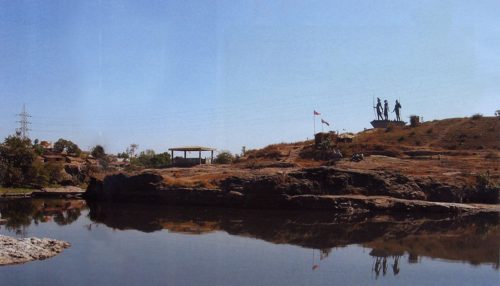
A Sculpture Of Sita Rama And Laksmana
When Lord Rama asked the sage Agastya to suggest an area where
He could build a hermitage, Agastya directed Him to this place.
As described in Valmiki's Ramayana, at the time of Lord Ramacandra the Nashik area was a peaceful and attractive forest that abundantly supplied all the needs of its inhabitants.
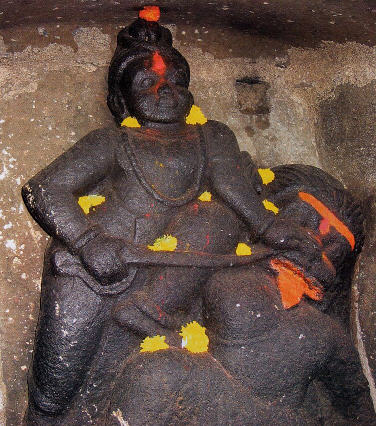
Lord Kapila Performed Austerities
The name Nashik derives from the word nasika, Sanskrit for "nose." It was here that Laksmana cut off the nose of the demoness Surpanakha, Ravana's younger sister.
On the first day of my stay in Nashik, my guide, Yogesh, suggested we visit the Triambakeshwar Temple, located in a small village twenty-eight kilometers from Nashik. The temple is dedicated to Lord Siva. (Tri means "three,"ambaka "eye," and isvara"controller.") This marvelous temple made of intricately carved black stone is famous because this is one of the twelve places where Lord Siva is self-manifested in a phallic form (jyotirlinga). He appeared here because he was pleased by the austerities of the sage Gautama. [See the sidebar "The Origin of Triambakeshwar."] The extraordinary feature of this jyotirlinga is that it has three faces: Brahma, Visnu, and Siva.
After seeing the deity of Lord Siva, we walked for about one kilometer and arrived at Kushavarta, a pond built by the sage Gautama. The pond is so named because it was formerly surrounded by kusha grass, used for worship. Today a pillared hall and a few temples surround it. The pond is at the foothills of Brahmagiri Mountain, the source of the Godavari River. On Brahmagiri, pilgrims visit a temple of Ganga Devi (the Ganges), a cave where sage Gautama performed austerities, and Rama-Lakshman Pond, where it is believed that Lord Rama stopped for a few days to performed ceremonies on behalf of his departed father, King Dasaratha.
The next day, in Nashik, we bathed in the sacred Ramkund, where people offer oblations to their forefathers, as Lord Rama did. Beside Ramkund is a small temple of the Godavari River. It is opened only every twelfth year, during the Nashik Kumbha-mela, a great festival.
After bathing, we went to Tapovan ("forest of penance"), situated on the bank of the Godavari and Kapila rivers some six kilometers south of Ramkund. On the spot where the Kapila meets the Godavari is Kapila Tirtha, where Lord Kapila performed austerities. Under a large banyan tree sits a small shrine where a deity of Lord Laksmana is worshiped. Next to it is a small room containing a sculpture of Laksmana cutting off the nose of Surpanakha. Local people believe this to be the spot where this incident took place.
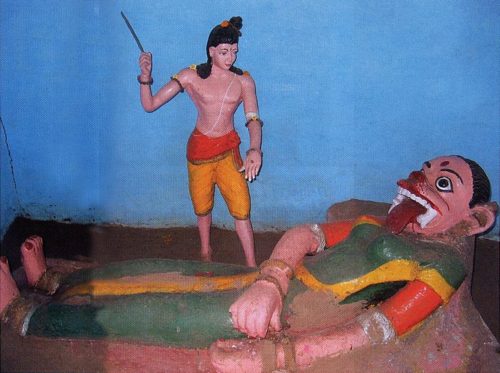
Laxman cutting the nose Surpanakha
The most interesting temples in Nashik are the Sundara Narayana Temple, the Kapaleswar Temple, the Naroshankar Temple, and the Kala Rama Temple, all built from black stone in eighteenth century. They are situated in the Panchavati area, close to the Godavari River. Panchavati is where Lord Rama, Laksmana, and Sita lived. [See the sidebar "At Home in Panchavati."] The name means "the place of five banyan trees," and even today there are five banyan trees here. Next to them is a wooden house in which there is a small cave called Sita Gumpha. Deities of Rama, Laksmana, and Sita are installed inside.
It is believed that Sita took shelter in this cave when an army attacked Lord Rama. Ravana kidnapped Sita in Panchavati, so that event, as well Lord Rama's killing of Marica in the form of a deer, are exhibited in the room across from Sitas cave.
Spending several days in Nashik, Yogesh and I found great inspiration visiting the holy places. But we were disappointed to see that pilgrims are more interested in performing rituals for material rewards than in learning about the activities of Lord Rama here. The renounced sages who live here were unable to answer our questions about the real spiritual significance of the place. Even in a holy place like Nashik, spiritual knowledge about our relationship with the Supreme Person seems to be lost under the influence of this age. Fortunately, we have found spiritual direction by hearing from previous spiritual masters in our line and from Srila Prabhupada and his faithful followers.
Adbhuta Hari Dasa, from Croatia, is based at the ISKCON temple in Baroda, Gujarat, India. He travels with a group of devotees distributing Srila Prabhupada's books.
Visiting Nashik
Nashisk is about 190 km northeast of Mimbai.
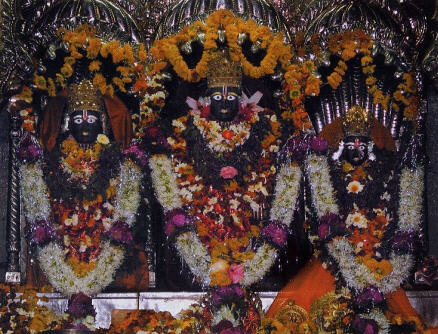
Deities Of Sri Rama Laxman Sita at Nashik
How to Get There
Air: The nearest airport is in Mumbai.
Rail: Trains between Mumbai and Nashik run twelve times a day. The trip takes about five hours. Trains leave from the main station in Mumbai, Chhatrapati Shivaji Terminus. Some Mumbai-Delhi trains stop in Nashik.
Bus: Private and government buses leave regularly from Dadar Station.
Car: It's about a fourhour drive up the Eastern Express Highway, NH3.
Where to Stay
Most of the hotels in Nashik are in the middle price range (Rs 200-600). Here are some suggestions: Raj Mahal Lodge (572-880), Padma (576-837), Hotel Holiday Plaza (573-521), Hotel Panchavati Ratri (571-273), Hotel Siddharth (573-288).
Where to Eat
Some good vegetarian restaurants: Woodlands Restaurant (across the street from Hotel Siddharth), Centre Point Restaurant (near Hotel Panchavati), Hotel Holiday Plaza Restaurant.
For more information, consult Holy Places and Temples of India, by Jada Bharata Dasa, available from the Krishna.com Store.
The Origin of Triambakeshwar
From Siva Purana
Once the sage Gautama performed great penance to invoke rain. When the deva Varuna, who is in charge of water, appeared before him, Gautama requested him to cause it to rain. Varuna replied that if Gautama pleased Lord Siva, his desire would be fulfilled.
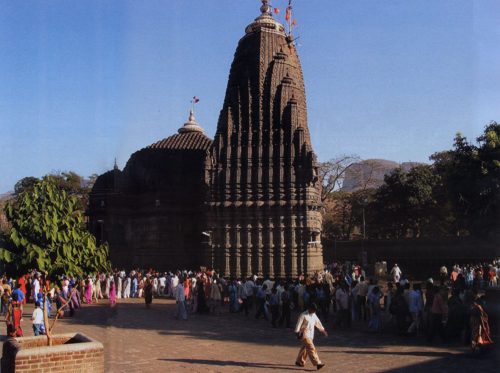
Triambakeshwar Temple at Nashik
Later, Varuna told Gautama to dig a pit, which Varuna then filled with water. Varuna blessed Gautama by saying that this pond would never dry up. The sages who had abandoned that place because of the drought then returned there.
One day, sage Gautama instructed his disciples to fetch some water from the pond. When the disciples reached there, they came upon the wives of numerous sages, who would not allow them to take water and instead rebuked them. The disciples returned to the hermitage and told Gautama what had happened.
Ahalya, Gautama's wife, pacified the angry disciples and went to the pond to fetch water. This became her daily routine. One day Ahalya met the wives of the sages at the pond, and they tried to prevent her from fetching water. When they returned to their hermitages and told their husbands what had happened, the sages became angry that Ahalya was trying to use the pond.
The sages worshiped Ganesa to please him. When Ganesa appeared, they requested him to drive Gautama from that place. At first Ganesa was reluctant to comply, but when they persisted he agreed at last. Disguised as a cow, Ganesa entered Gautama's barley field and started grazing. Gautama tried to drive out the cow by hitting her on the back with a bundle of grass. The artificial cow died instantly. Gautama was very sorry for his act. But when all the sages from the surrounding area arrived there, they forced Gautama to abandon that place at once.
Gautama left and made his hermitage at a little distance from there. One day he came to the sages and asked them how he could atone for his sin of killing a cow. The sages told him that he would have to walk around the earth three times, all the while saying, "I have killed a cow." They also told him that after that he would have to perform austerities for one month.
As an alternative, the sages said that Gautama could help Ganga manifest herself and take bath in her water. Or he could worship thirty million Siva lingas.
Gautama made the Siva lingas and started worshiping them. Lord Siva, pleased by his devotion, appeared before him. Gautama requested Lord Siva to free him from the sin of killing a cow. He also requested Lord Siva to manifest the river Ganges there.
Lord Siva tried his best to make Gautama understand that he was innocent and that the real culprits were the wicked sages. But Gautama was unconvinced. At last Siva instructed Ganga to appear in the form of a woman. Gautama eulogized Ganga, and by the blessings of Lord Siva, Gautama was freed from the sin of killing a cow.
When Ganga asked to leave, Lord Siva asked her to stay on the earth. Ganga consented on the condition that Lord Siva and Goddess Parvati would also stay on earth. So Lord Siva established himself as Triambakeshwar jyotirlinga, and Ganga becamefamous as Gautami Ganga.
At Home in Panchavati
From Ramayana,
by Kamala Subramaniam
(Bharatiya Vidya Bhavan, Bombay, 1988).
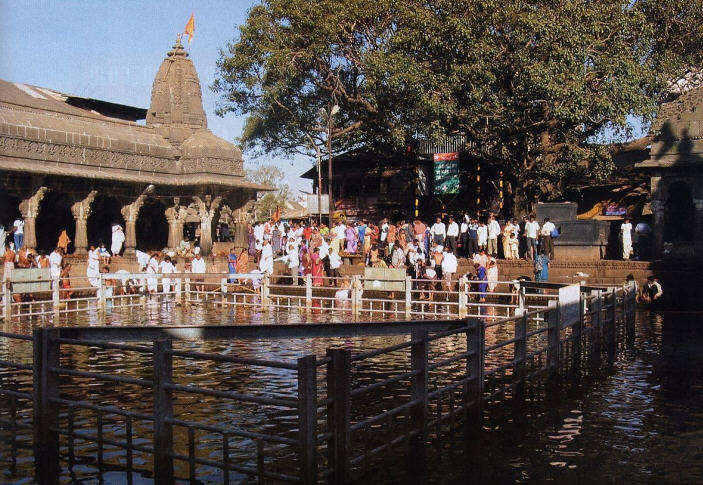
Kushavarta Pond
They had arrived at Panchavati. Rama looked around and said: "Lakshmana, this is the place which was indicated by the sage Agastya. Look at those trees laden with flowers and the river which is so near! This must be Panchavati. Look around, Lakshmana. You know only too well the kind of place I would like. Look for a place where there is enough water for us to perform our daily worship of the gods. Sita should be happy and we should have peace. Trees should be around and Samith [firewood], darbha grass and flowers should be within reach. Build for us an ashrama in such a place."
Lakshmana said: "I am but your servant, Rama. I will build the ashrama but the choice of the location should be yours. I will not presume to know where it should be." Rama smiled at the words of Lakshmana and together they looked around for a suitable site. After some rambling around they found the ideal place. Rama took Lakshmana's hand in his and said: "Look, this place seems to me to be best suited for our purpose. The ground is level and it is surrounded by trees in abundance. Build an ashrama here for us. Close by is a small stream, and the perfume of lotuses floating on its surface reaches us here. And just across, some distance from here, is the river Godavari which the rishi told us about. There are mountains, and herds of deer are roaming on the slopes. Peacocks are dancing everywhere and the mountains have several minerals that glow red, white and yellow. The green of the trees together with these colours present the appearance of a painted picture. The elephants stand out against this colourful background as though they are etched in space. I like this picturesque Panchavati. Let us live here."
Lakshmana built an ashrama there on the site indicated by Rama. He brought lotuses from the river Godavari after bathing in it. He made an offering of flowers to the gods that guarded the forest and spoke words prescribed for averting evil. He went to Rama and Sita. He told them that the ashrama was ready for them.
Rama saw how well-planned it was and how sturdily built. He was enchanted with it. He embraced Lakshmana warmly and said: "I am very pleased with you. You have done me a very good service and the only way I can thank you for it is to embrace you. You are wise, you are righteous, and, even without being told about it, you know what my wishes are. My father, I think, is not dead but is here, before me in the form of my brother." Rama was shedding tears of joy and Lakshmana stood with an embarrassed smile on his face.
They lived happily in that ashrama for a long while without any disturbance. Sita enjoyed collecting flowers and stringing them, making friends with the birds, the deer and the peacocks. Rama was like Indra in Amaravati. He was happy.
